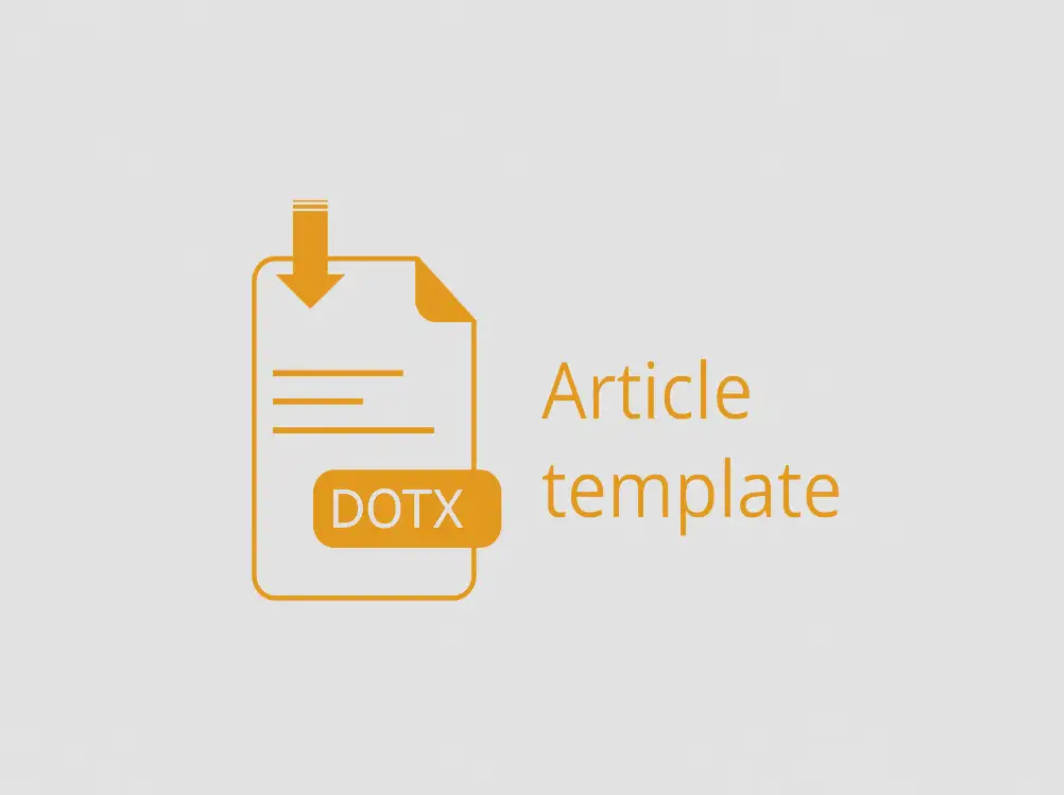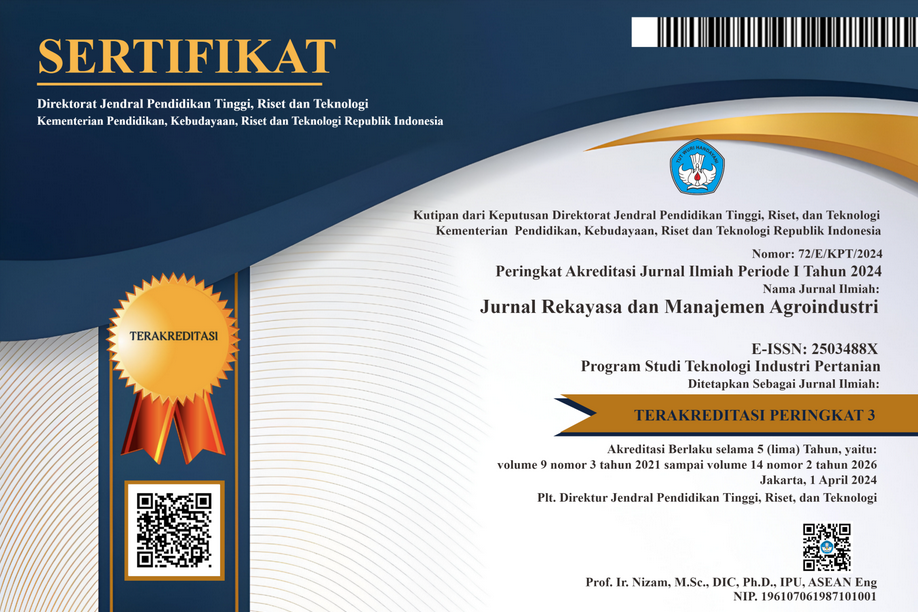Karakteristik Mikroemulsi Minyak Atsiri Daun Cengkeh Pada Rasio Campuran Surfaktan dan Minyak Atsiri Daun Cengkeh (Syzygium aromaticum)
Abstract
ABSTRACT
Clove (Syzygium aromaticum) is an herbal plant which all parts starting from the roots, stems, leaves and flowers contain essential oils. Clove leaf essential oil has an eguanol concentration of (46.69%-64.91%) which functions to fight bacteria that enter the body. This research aims to determine the effect of surfactant and clove leaf essential oil mixtures on the characteristics of clove leaf essential oil microemulsions and determine the best surfactant and clove leaf essential oil mixtures to produce clove leaf essential oil microemulsions. This research used Randomized Group Design, with surfactant:clove leaf essential oil ratio with 10 levels, 100:0; 98:2; 96:4; 94:6; 92:8; 90:10; 88:12; 86:14; 84:16 and 82:18. The best microemulsion is the one with highest concentration of clove leaf essential oil. The best microemulsion was tested for stability against pH and dilution during 8 weeks storage. The turbidity index value was tested every 2 weeks. The deterioration rate was calculated using linear regression analysis to determine the stability of clove essential oil microemulsion. The results showed that the ratio of surfactant and clove leaf essential oil mixture had a very significant effect (P<0.01) on the characteristics of clove leaf essential oil microemulsion. The ratio of surfactant and clove leaf essential oil 88:12 is the best treatment to produce clove leaf essential oil microemulsion with transparent appearance characteristics, turbidity index value before 0.223 ± 0.003%; after centrifugation 0.189 ± 0.003%; particle size 17.1 ± 8.3 nm, and the largest droplet size is 14nm and stable for 8 weeks of storage.
Keywords : Syzygium aromaticum, microemulsion, ratio, surfactant.
ABSTRAK
Cengkeh (Syzygium aromaticum) merupakan merupakan tumbuhan herbal yang semua bagiannya mulai dari akar, batang, daun dan bunga mengandung minyak atsiri atau essential oil. Minyak atsiri daun cengkeh memiliki kandungan eguanol sebesar (46,69%–64,91%) yang berfungsi melawan bakteri yang masuk ke dalam tubuh. Penelitian ini bertujuan untuk mengetahui pengaruh rasio campuran surfaktan dan minyak atsiri daun cengkeh terhadap karakteristik mikroemulsi minyak atsiri daun cengkeh serta menentukan rasio campuran surfaktan dan minyak atsiri daun cengkeh terbaik untuk menghasilkan mikroemulsi minyak atsiri daun cengkeh. Percobaan ini menggunakan Rancangan Acak Kelompok (RAK), dengan perlakuan rasio surfaktan:minyak atsiri daun cengkeh dengan 10 taraf yaitu 100:0; 98:2; 96:4; 94:6; 92:8; 90:10; 88:12; 86:14; 84:16 dan 82:18. Mikroemulsi terbaik yaitu mikroemulsi yang mempunyai konsentrasi minyak atsiri daun cengkeh tertinggi. Mikroemulsi terbaik diuji stabilitas terhadap pH dan pengenceran selama penyimpanan 8 minggu. Pengujian nilai indeks turbiditasnya dilakukan setiap 2 minggu. Laju kerusakan dihitung menggunakan analisis regresi linier untuk mengetahui stabilitas mikroemulsi minyak atsiri cengkeh. Data dianalisis dengan analisis varian dan dilanjutkan uji BNJ. Hasil penelitian menunjukkan rasio campuran surfaktan dan minyak atsiri daun cengkeh berpengaruh sangat nyata (P<0,01) terhadap karakteristik mikroemulsi minyak atsiri daun cengkeh. Rasio surfaktan dan minyak atsiri daun cengkeh 88:12 merupakan perlakuan terbaik untuk menghasilkan mikroemulsi minyak atsiri daun cengkeh dengan karakteristik kenampakan yang transparan, nilai indeks turbiditas sebelum 0,223± 0,003%; sesudah sentrifugasi 0,189± 0,003% ; ukuran partikel 17,1±8,3 nm, dan ukuran droplet terbanyak yaitu 14nm serta stabil selama 8 minggu penyimpanan
Kata kunci : Syzygium aromaticum, mikroemulsi, rasio, surfaktan.
Downloads
References
Cui, J., B. Yu, Y Zhao, W. Zhu, H. Li, H. Lou, and G. Zhai. 2009. Enhancement of oralabsorption of curcumin by self-microemulsifying drug delivery systems. International Journal of Pharmaceutical 371: 148-155.
Dehghani, F., A. Heshmatpour, M. R. Panjehshahi and T. T. Khozain. 2012. Toxic effects of water/alcoholic extract of Syzygium aromaticum on sperm quality, sexhormones and reproductive tissues in male mouse. IUFS J Biol 71 (2): 95 – 102.
Dwipayana, I. M., Suhendra, L., & Triani, I. G. L. (2022). Pengaruh Rasio Campuran Surfaktan dan Minyak Atsiri Jahe (Zingiber Officinale Var. Amarum) terhadap Karakteristik Mikroemulsi yang Dihasilkan. Rekayasa DanManajemen Agroindustri, 10(1), 1–11.
Fletcher, P.D.I. dan K. Suhling. 1998. Interactions betweenweakly charged oil-in-watermicroemulsion droplets. Langmuir 14: 4065-4069.
Huang, Y, H. Shuit-Hung, L. Hsien-Chieh, dan Y. Yen-Ling. 2002. Insecticidal properties of eugenol , isoeugenol and methyleugenol and their effects on nutrition of Sitophilus zeamais Motsch . (Coleoptera : Curculionidae) and Tribolium castaneum (Herbst) (Coleoptera : Tenebrionidae).
Journal of Stored Product Research, 38:403–412.
Joshita. 2002. Buku Petunjuk Praktikum Farmasi Fisika. Jurusan Farmasi FMIPA-UI, Depok. 52-54. Kim, S. 2009. Microemulsion Formulation of Natural Plant Oils for Topical Delivery.
Kumala, Shirly, dan Dian Indriani. 2008. Efek Antibakteri Ekstrak Etanol Daun Cengkeh (Eugenia aromaticum L). Jurnal Farmasi Indonesia , 4(2):82-86.
Lim, W. H. 2006. Phase diagram, viscosity and conductivity of α-sulfonate methyl esters derived from palm stearin/1-butanol/alkane/water systems. Journal of Surfactants and Detergents 9(4):349-355.
Lund, Walter. (1994). The Pharmaceutical Codex, 12th edition, The Pharmaceutocal Press, London.
McClements, D. J., E. A. Decker, and J. Weiss. 2007. Emulsion-based delevery systems for lipophillic bioactive components. J. FoodScience. 72:109-124.
Nurdjannah, N. 2004. Diversifikasi penggunaan cengkeh, Balai Besar Penelitian dan Pengembangan Pasca Panen Pertanian, Bogor. 3 (2):61-70.
Prasanta Adi, I. P. H., Suhendra, L., & Wrasiati, L. P. (2021). Karakteristik Mikroemulsi MinyakDaun Sirih (Piper betle L.) pada Perlakuan Rasio Campuran Surfaktan dan Minyak Daun Sirih. Rekayasa Dan Manajemen Agroindustri,9(4), 1–11.
Sari, K. D., dan R. S. Dhamar. 2015. Pengaruh waktu dan kecepatan pengadukan terhadap emulsi minyak biji matahari (Helianthus annuus L.) dan Air. Vol. 5 (3) : 155-159.
Suhendra, L., S. Raharjo, P. Hastuti, dan C. Hidayat. 2012. formulasi dan stabilitas mikroemulsi m/a sebagai pembawa fucoxanthin. Vol. 32 (3).
Sucitawati, P. A., L. Suhendra, dan G. P. Ganda Putra. 2021. Pengaruh perbandingan campuran tiga surfaktan nonionik dan lama pengadukan terhadap karakteristikmikroemulsi α-Tokoferol. Jurnal Rekayasa dan Manajemen Agroindustri. 9(1):33-41.
Talegaonkar, S., A. Azeem, F. J. Ahmad, R. K. Kahar, S. A. Pathan, dan Z. I. Khan.2008.
Microemulsions: a novel approach to enhanced drug delivery. Recent Patents on Drug Delivery & Formulation, 2, 238-257.
Velluti, A., V. Sanchis, A. J. Ramos, J. Egido, S. Marin. 2003. Inhibitory effect of cinnamon , clove , lemongrass , oregano and palmarose essential oils on growthand fumonisin B 1 production by Fusarium proliferatum in maize grain. International Journal of Food Microbiology, 89:145–154

Ciptaan disebarluaskan di bawah Lisensi Creative Commons Atribusi-BerbagiSerupa 4.0 Internasional.
Seluruh artikel di Jurnal ini dapat disebarluaskan atas tetap mencantumkan sumber yang syah. Identitas judul artikel tidak boleh dihilangkan. Penerbit tidak bertangggung jawab terhadap naskah yang dipublikasikan. Isi artikel menjadi tanggung jawab Penulis.














